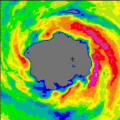 An understanding of how hurricane convection behaves, organizes, and influences storm evolution is important. Convection directly provides the latent heat release and vertical transport of mass and energy required to maintain the warm core. The organization of this convection is influenced by internal dynamics as well as large-scale environmental forcings and ocean–atmosphere interactions. Any organizational change can feed back upon the local environment to influence subsequent convection and storm evolution. These processes must be better understood before significant advancements in hurricane intensity prediction can be achieved. While great strides in understanding hurricane internal dynamics have been made since instrumented aircraft began routine penetrations, our understanding of inner-core cumulus convection remains limited, despite its well-recognized crucial role.
An understanding of how hurricane convection behaves, organizes, and influences storm evolution is important. Convection directly provides the latent heat release and vertical transport of mass and energy required to maintain the warm core. The organization of this convection is influenced by internal dynamics as well as large-scale environmental forcings and ocean–atmosphere interactions. Any organizational change can feed back upon the local environment to influence subsequent convection and storm evolution. These processes must be better understood before significant advancements in hurricane intensity prediction can be achieved. While great strides in understanding hurricane internal dynamics have been made since instrumented aircraft began routine penetrations, our understanding of inner-core cumulus convection remains limited, despite its well-recognized crucial role.
Past research efforts were directed toward better understanding the various mechanisms that control the timing, location, and intensity of convection in the tropical cyclone core. Our primary approach was through extensive analysis of a wide variety of aircraft-based observations (e.g., Doppler radar, GPS dropwinsondes, and traditional flight-level data). The observational results are compared to theoretical expectations and numerical simulations of tropical cyclones.
This research was funded through a grant from the National Science Foundation in collaboration with Drs. Paul Reasor, John Gamache, and Frank Marks at the NOAA Hurricane Research Division.
Relevant Publications and Presentations:
Reasor, P.D., and M.D. Eastin, 2012: Rapidly intensifying Hurricane Guillermo (1997). Part II: Resilience in shear. Monthly Weather Review, 140, 425-444
Reasor, P.D., M.D. Eastin, and J.F. Gamache, 2009: Rapidly intensifying Hurricane Guillermo (1997). Part I: Low wavenumber structure and evolution. Monthly Weather Review, 137, 603-631.
Eastin M.D., and P.D. Reasor, 2012: Evolution of mass transport between the eye and eyewall of Hurricane Guillermo (1997), 30th Conference on Hurricanes and Tropical Meteorology, Jacksonville, FL, American Meteorological Society
Eastin, M.D., and P.D. Reasor, 2010: Modulation of eyewall convection by eye-eyewall mesovortices during the rapid intensification of Hurricane Guillermo (1997). 29th Conference on Hurricanes and Tropical Meteorology, Tucson, AZ, American Meteorological Society
Eastin, M.D., and P.D. Reasor, 2008: Evolving low-wavenumber flow and the distribution of deep eyewall convection during the rapid intensification of Hurricane Guillermo (1997). 28th Conference on Hurricanes and Tropical Meteorology, Orlando, FL, American Meteorological Society